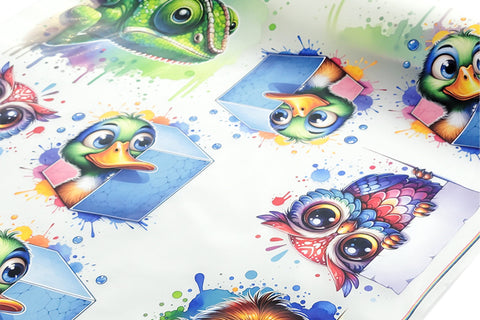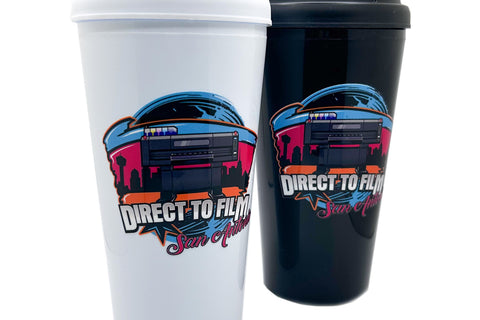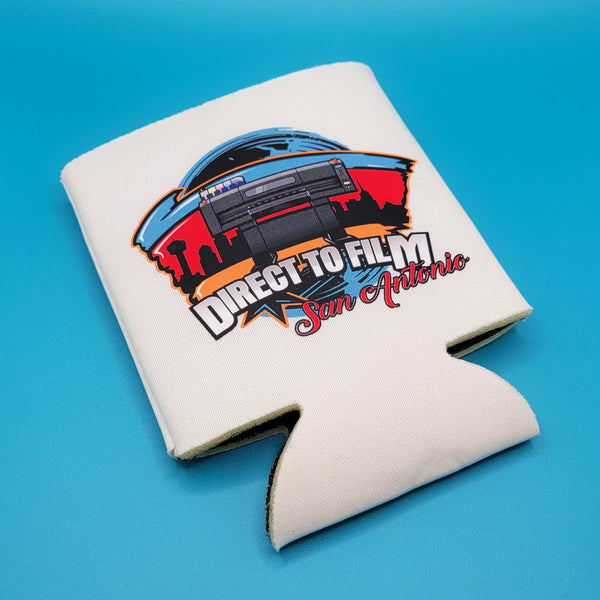If you are in the printing business or planning to start, you have probably come across the two famous printing methods: DTF (Direct to Film) and sublimation printing. Both options are suitable for custom apparel and product decoration, but serve very different purposes.
So, selecting the right printing method according to your business type, production quality, and versatility is important. Confused? No worries! Just spare a few moments and read this guide to know the difference between DTF vs Sublimation.
What is DTF Printing?
DTF printing is a new and highly adopted printing method that involves an easy process. In this, you can print a design directly on the PET film using a DTF printer equipped with CMYK and white inks. Then, apply a thermoplastic adhesive powder to the wet ink, which then sticks to the design.
Finally, cure the film with a heat press and apply the designed film to the fabric with a heat press. The result will be vibrant printed apparel.
What is Sublimation Printing?
Sublimation printing is a more established method that relies on a unique chemical process. Special sublimation inks are printed onto transfer paper. When heated to high temperatures (typically 350-400°F or 175-200°C) under pressure, these inks transform directly from a solid state into a gas (sublimate) without becoming liquid.
This gaseous dye then permeates and permanently bonds with the polyester fibers of the material. The result is a print that is literally in the fabric.
Difference Between DTF vs. Sublimation
Now, we are going to discuss a few important aspects that differentiate these two powerful printing methods.
Fabric Compatibility & Material Versatility
What fabrics can DTF print on? Don't be confused, with DTF you can get great fabric versatility because it almost works on every fabric which including:
-
100% cotton and cotton blends, which is a prominent win over sublimation.
-
Polyester and polyester blends
-
Nylon, rayon, silk, denim, leather
-
DTF prints effectively on both light and dark-colored garments due to its white ink layer. This opens up a vast market for custom apparel on black t-shirts, dark hoodies, and other traditionally challenging items.
Sublimation printing offers the best quality but only on specific materials. Sublimation has inherent material limitations:
-
Those asking, can I sublimate on cotton? No! You cannot sublimate on 100% cotton, but it works best on polyester fabrics.
-
It also works best on hard goods like mugs, phone cases, keychains, ceramic tiles, and metal panels.
-
Limited to white or light-colored fabrics because sublimation inks are translucent. So, if your design has white parts, they won’t show up as white; they’ll just take the base color of the fabric. That’s why sublimation only works well on white or light-colored fabrics. On dark fabrics, the colors get lost and look dull or invisible.
Color Reproduction & White Ink Capabilities
The inclusion of white ink in the DTF process is a major differentiator. This allows for printing vivid, opaque designs on any color garment. It also allows gradients and photorealistic images to be accurately reproduced on dark substrates.
Sublimation operates well on a CMYK (Cyan, Magenta, Yellow, Black) color model and fundamentally cannot print white ink. Any white areas in your design will appear as the color of the base fabric.
Cost Analysis
DTF Printing
The initial setup cost is generally higher than a basic sublimation setup. A DTF printer ranging from desktop models at $2,000-$5,000 to industrial ones at $15,000+, a powder shaker/applicator $500-$5,000+, and a curing oven or heat press are required.
Consumables cost includes DTF inks (CMYK + White), DTF film rolls, and DTF adhesive powder. The film and powder are relatively affordable, but white ink consumption impacts per-print costs.
The higher versatility opens up a much larger market, which leads to a faster ROI for businesses targeting diverse apparel. For small businesses, DTF is a profitable venture.
Sublimation Printing
The initial setup cost for sublimation is lower. A dedicated sublimation printer (Epson converted or Sawgrass models from $500-$3,000) and a heat press ($300-$800) are the primary investments.
Consumables cost includes only sublimation inks, sublimation paper, and the cost of polyester blanks. Paper and ink are generally affordable, but the cost of specialized polyester garments or coated blanks can add up.
There is a high return on investment because sublimation is excellent for businesses specializing in polyester sportswear, promotional items (mugs, phone cases), or full-bleed designs where the entire product is sublimated.
Print Quality, Feel, and Durability
DTF prints are known for their vibrant, opaque colors and sharp, detailed resolution. The white underbase ensures colors pop, even on dark backgrounds. The print sits on top of the fabric, similar to a screen print or vinyl transfer.
DTF prints result in a slightly raised feel, but you will get the premium DTF transfers that can withstand 50 plus washes without cracking or fading if applied correctly.
Whereas sublimation produces a print that is truly part of the fabric, resulting in zero hand feel. It is incredibly soft and breathable, feeling like the original material. The colors are vibrant and offer permanence.
Sublimated prints will never crack, peel, or fade because the dye has infused into the fibers. They can withstand hundreds of washes and prolonged exposure without degradation.
Ease of Use & Workflow
A DTF printing process involves multiple steps such as printing to film, powder application, curing, and heat pressing. Printer maintenance, especially preventing white ink clogs, is also a vital consideration. However, advancements in automated DTF systems are simplifying the process.
Sublimation printing has a simpler process because it just involves printing on paper and then heat pressing. Fewer steps, like powder application and curing, can make it less intimidating initially. However, achieving perfect color profiles and avoiding white creasing on folds requires practice.
Market Trends and Future Outlook
DTF and sublimation printing methods differ in their market niches but are experiencing almost the same growth.
The global DTF printer market was estimated at USD 965.82 million previous year and is projected to reach USD 1,398.32 million by 2030. It is growing at a CAGR of 6.36%. The growth is led by versatility, the ability to print on diverse fabrics, especially cotton, and the increasing demand for customized apparel.
The global dye sublimation printing market size was estimated at USD 14.9 billion last year and is projected to grow at a CAGR of 11.3% from 2025 to 2030. This robust growth is encouraged by the demand for high-quality, durable prints on polyester fabrics for sportswear, fashion, and promotional products.
These figures show that both printing methods are booming, serving different, yet sometimes overlapping, market segments.
When to Choose Direct to Film Printing?
You can choose the DTF printing method if your need is to print on a wide array of fabrics, including cotton, cotton blends, and dark-colored garments. Plus, your designs include white elements or require high opacity and vibrant colors that pop on any background.
It is also preferable if you are looking for commercial-grade custom apparel production with a broad product catalog, but you prioritize short runs and on-demand printing for personalized items.
When to Choose Sublimation Printing?
Compared to DTF printing, sublimation is suitable if your focus is mainly on polyester fabrics like sportswear, activewear, performance wear, and sublimation-coated hard goods. Your designs do not require white ink and are best suited for white or very light-colored substrates.
Plus, you value permanence and durability, where prints will not crack, peel, or fade over the lifetime of the product. Moreover, this is also suitable for those who want to spend less on initial investment to start a custom printing business.
I hope now you understand the difference between Direct to Film printing (DTF) and Sublimation and can choose the suitable printing method. Share your thoughts below:










